All About Horseradish
Horseradish’s scientific name (or binomial name) is Armoracia Rusticana. It is a perennial plant from the Brassicaceae family, which includes wasabi, broccoli, mustard and cabbage. It is most commonly grown for its root and can grow as tall as five feet. The root itself has no smell, but when grated, enzymes from the plant break down a glucosinolate called sinigrin, which produce a type of mustard oil called allyl isothiocyanate. Once the root has been grated it must be used, or mixed in vinegar, in order for it to keep its zest. If it is left exposed to air and heat it will darken and become unpleasantly bitter.
FAQs
How is fresh horseradish ground?
 Grind fresh horseradish roots in a well-ventilated room. The fumes from grinding are potent. A whiff may be stronger than you expect!
Grind fresh horseradish roots in a well-ventilated room. The fumes from grinding are potent. A whiff may be stronger than you expect!
Using a blender for grinding makes home preparation practical and less tearful.
To grate your own horseradish, wash and peel the root as you would a potato and dice it into small cubes. Place the cubes in the blender jar. Process no more than half a container load at a time. Add a small amount of cold water and crushed ice. Start with enough cold water to completely cover the blades of the blender. Add several crushed ice cubes. Put the cover on the blender before turning the blender on. If necessary, add more water or crushed ice to complete the grinding. When the mixture reaches the desired consistency, add white vinegar. Use two to three tablespoons of white vinegar and half teaspoon of salt for each cup of grated horseradish (One tablespoon of sugar may be substituted for the salt).
If desired, lemon juice may be substituted for the vinegar to give it a slightly different flavor. The time at which you add the vinegar is important. Vinegar stops the enzymatic action in the ground product and stabilizes the degree of hotness. If you like horseradish that is not too hot, add vinegar immediately. If you like as hot as can be, wait three minutes before adding the vinegar. Place the mixture in small glass jars and screw the lids on firmly. Store in the refrigerator or freezer.
Fresh horseradish may also be finely shaved or grated and added directly to the food. This simple method is frequently used by discriminating cooks. Fine shavings may also be placed in a dish of lemon juice to be served at the table.
What makes horseradish hot?
The sharp and piquant flavor and penetrating smell of horseradish become apparent when the root is grated or ground. This is because the root contains highly volatile oils that are released by enzyme activity when the root cells are crushed.
If exposed to air or stored improperly, horseradish looses its its pungency rapidly after grinding.
How to keep horseradish hot?
To keep prepared horseradish (commercial or homemade) and its flavor best, store it in a tightly covered jar in the refrigerator or in the freezer. Be careful to allow room for expansion when storing glass jars in the freezer. It will keep its good quality for about four to six weeks in the refrigerator and for six months or longer in the freezer. Buy or prepare only the amount of horseradish that can be used in a reasonable time. Fresh roots may be stored for several months if they are washed, placed in polyurethane bags, and stored at 32 – 38 degrees Fahrenheit.
How did horseradish get its name?
Horseradish has nothing to do with horses, and it is not a radish. It is a member of the mustard family. The name may have come from an English adaptation of its German name. In early times the plant grew wild in European coastal areas. The Germans called it “Meerrettich” or “Searadish”. The German word “meer” sounds like “mare” in English. Perhaps “mareradish” eventually became “horseradish”.
The word “Horseradish” first appeared in print in 1597 in John Gerarde’s English Herbal or Medicinal Plants.
Other Information
Nutritional Value* of Horseradish
Horseradish contains potassium, calcium, magnesium and phosphorus, as well as volatile oils, such as mustard oil (which has antibacterial properties due to the antibacterial mechanism of allyl isothiocyanate). Fresh, the plant contains average 79.31 mg of vitamin C per 100 g of raw horseradish.
*www.wikipedia.com
Horseradish Stats*
In the U.S. an estimated 24 million pounds of horseradish roots are ground and processed annually to produce approximately 6 million gallons of prepared horseradish — enough to generally season sandwiches to reach 12 times around the world.
The “hotness” from horseradish comes from isothiocyanate, a volatile compound that, when oxidized by air and saliva, generates the “heat” that some people claim clears out their sinuses.
Horseradish dates back 3,000 years and has been used as an aphrodisiac, a treatment for tuberculosis, a rub for low back pain, a bitter herb for Passover and an accompaniment for corned beef, chicken and seafood.
Horseradish is a hardy perennial member of the Cruciferae or mustard family and is harvested in the spring and fall. Its cousins are kale, cauliflower, Brussel sprouts and the radish.
One tablespoon of horseradish has only six calories and no-fat. The National Heart, Lung, and Blood Institute recommends horseradish as part of a healthy, low-fat diet because of its fat-free, high-flavor qualities.
*Horseradish Information Council – www.horseradish.org
Medicinal Uses* of Horseradish Root
Known to have diuretic properties, the roots have been used to treat various minor health problems, including urinary tract infections, bronchitis, sinus congestion, ingrowing toenails and coughs. Compounds found in horseradish have been found to kill some bacterial strains
*Pleasant, Barbara (Oct-November 2003). “Horseradish”. Mother Earth News. Retrieved 2007-07-01.
